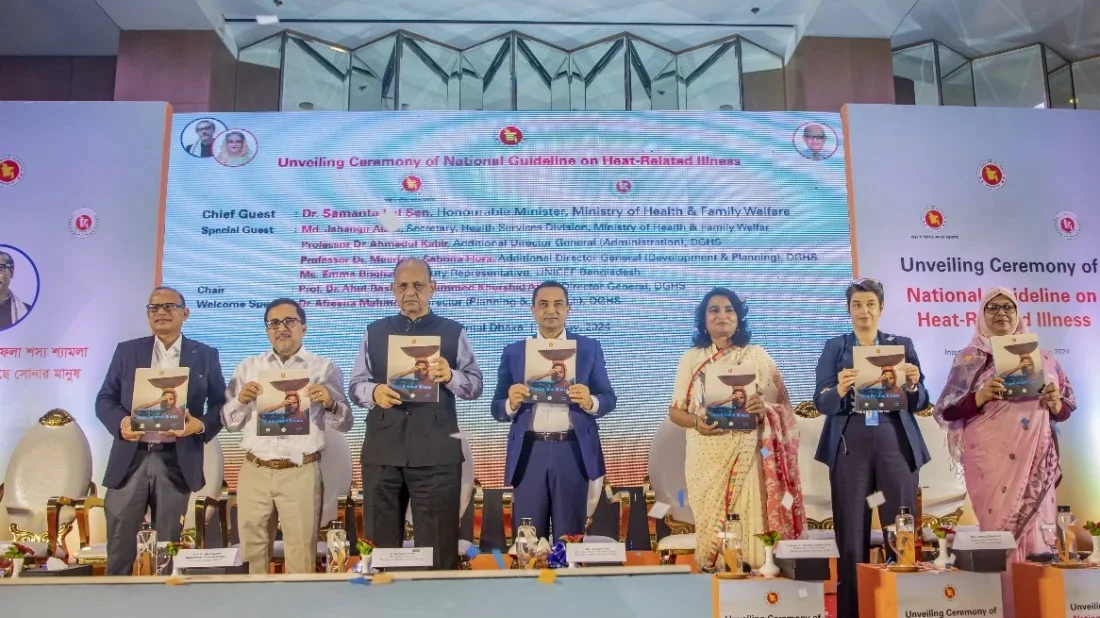Bangladesh launches national guidelines to combat heat-related health risks
Share on:

The guidelines will be disseminated through various ministries, mass media
In a significant step forward in Bangladesh’s heath sector, the Directorate General of Health Services (DGHS) in Bangladesh, with Unicef's support, has launched a national guideline to protect children and vulnerable populations, including pregnant women from heat-related health risks.
Health and Family Welfare Minister Dr Samanta Lal Sen announced the launch of this guideline, emphasizing its crucial timing amidst changing weather patterns attributed to climate change.
Unicef has provided full support for the development of this policy, recognizing its importance in addressing the rising temperatures and associated health risks.
The national guidelines, jointly developed by DGHS with Unicef support, stress the importance of a primary healthcare approach in protecting vulnerable populations from the adverse effects of climate change.
Meerjady Sabrina Flora, additional director general (Planning and Development) of DGHS, outlined the key aspects of the guidelines during the launch event on Sunday.
At the event, Dr Samanta Lal Sen highlighted the timeliness of the guideline, saying that people across the country are facing multitude of problems due to ongoing heatwave across the country.
Since April 19, Bangladesh Meteorological Department (BMD) issued heat alert six times.
The health minister said proactive measures, including online training for healthcare professionals, will effectively implement the guideline nationwide.
"When the heat reached its peak, I gave only one instruction to everyone. Keep the hospitals empty. All diseases that can be operated on and treated later are closed for the time being and our hospitals are ready,” he said.
"While we may not have control over natural disasters, our ministry's main responsibility lies in safeguarding public health amidst rising temperatures. Emphasizing urbanization, we must prioritize tree planting initiatives to mitigate heat-related health risks," Dr Samanta Lal added.
Acknowledging the collaborative effort, the health minister expressed gratitude to Unicef for their support in developing the guidelines.
Unicef Bangladesh Deputy Representative Emma Bringham emphasized the severity of the heatwave situation, underscoring the crucial role of the guidelines in promoting public health and safety during the summer months.
National guidelines
The national guidelines, developed in collaboration with experts from health and other sectors, provide a comprehensive framework for responding effectively to heat-related health risks.
In addition, the guidelines include Unicef’s B.E.A.T. the Heat framework, based on the English acronym: 1) BE AWARE of heat stress and protect yourself; 2) EASILY IDENTIFY the symptoms of heat stress; 3) ACT IMMEDIATELY to protect yourself and others; and 4) TAKE the person to a health facility if an individual is showing serious symptoms.
These directives are aimed at raising public awareness and fostering mass participation in heat-related health initiatives.
These guidelines will be disseminated widely through various government ministries, mass media channels, and grassroots organizations to ensure broader community and public engagement.
The guidelines categorize activities and recommendations into three distinct seasons: pre-heat swell, heat season, and post-heat season.
Within each season, specific directives are provided for various Department of Health activities, including hospital operations, community clinic management, hospital logistics, drug supply, and summer treatment protocols.
These guidelines are designed to facilitate the training of healthcare workers, encompassing doctors and nurses, to effectively manage healthcare services throughout different phases of the year, thereby optimizing response and care delivery during periods of heightened heat-related health risks.
"Every child has the right to a healthy environment, and we all have a role to play. By addressing heat-related illnesses and prioritizing skills for healthcare professionals, we can help pave the way for a healthier and brighter future for children in Bangladesh," said Sheldon Yett, representative of Unicef in Bangladesh.
Unicef: Bangladesh will experience 4 heatwaves every year
According to recent projections from Unicef and as a stark reminder of climate change, by 2050 a staggering 35.5 million children in Bangladesh, 99% of the total child population at that time, are set to face high heatwave frequency, meaning on average 4.5 or more heatwaves per year.
This will be a significant surge from 2020, when just 2.6 million children, representing 5 per cent, were exposed to such risks.
Unicef estimates that one in three children in Bangladesh, nearly 20 million children, bear the brunt of climate change every day.
Children are victims of extreme weather, such as the current heatwaves, floods, river erosion, sea level rise, and other environmental shocks driven by climate change.
Due to extreme heat wave in Bangladesh especially during the humid months from April to August it is creating many health risks for people.
The extreme heatwave experienced in Bangladesh, particularly during the humid months from April to August, poses significant health risks for its population.
With every 1°C rise in temperature, the likelihood of preterm birth increases by 5%, escalating to 16% during heatwaves compared to non-heatwave periods.
This underscores the heightened risk of preterm birth during intense heatwaves, indicating a correlation between the intensity of heatwaves and the elevated risk.
Bangladesh already grapples with one of the world's highest rates of preterm births at 16.2%, a figure expected to surge further during heatwaves.
Additionally, mental health deteriorates, physical work capacity diminishes, and the incidence of kidney and lung-related issues rises during heatwaves.
Pregnant women, newborns, and the elderly are especially vulnerable to the adverse effects of heatwaves, necessitating targeted interventions and heightened awareness to mitigate these risks.

